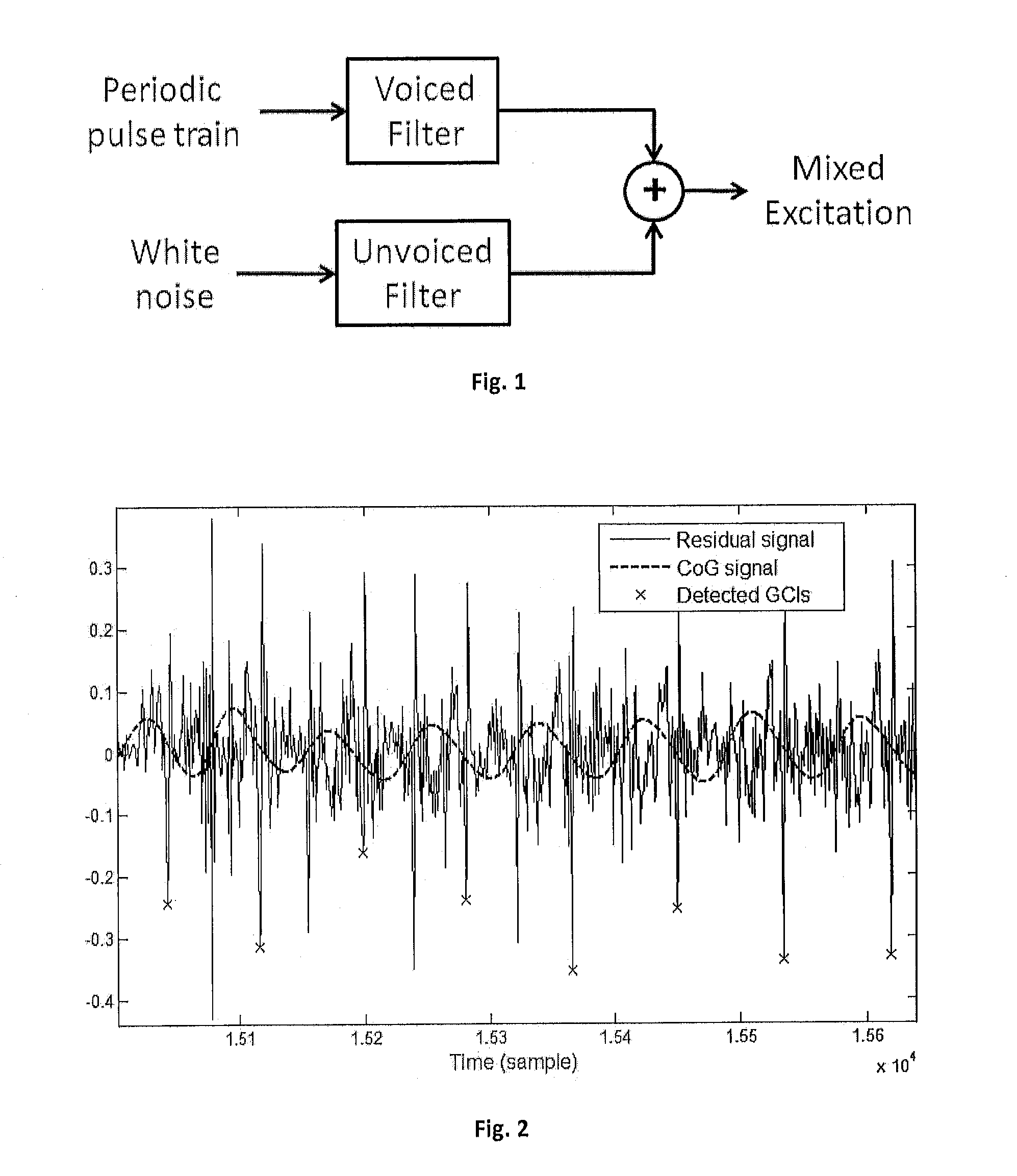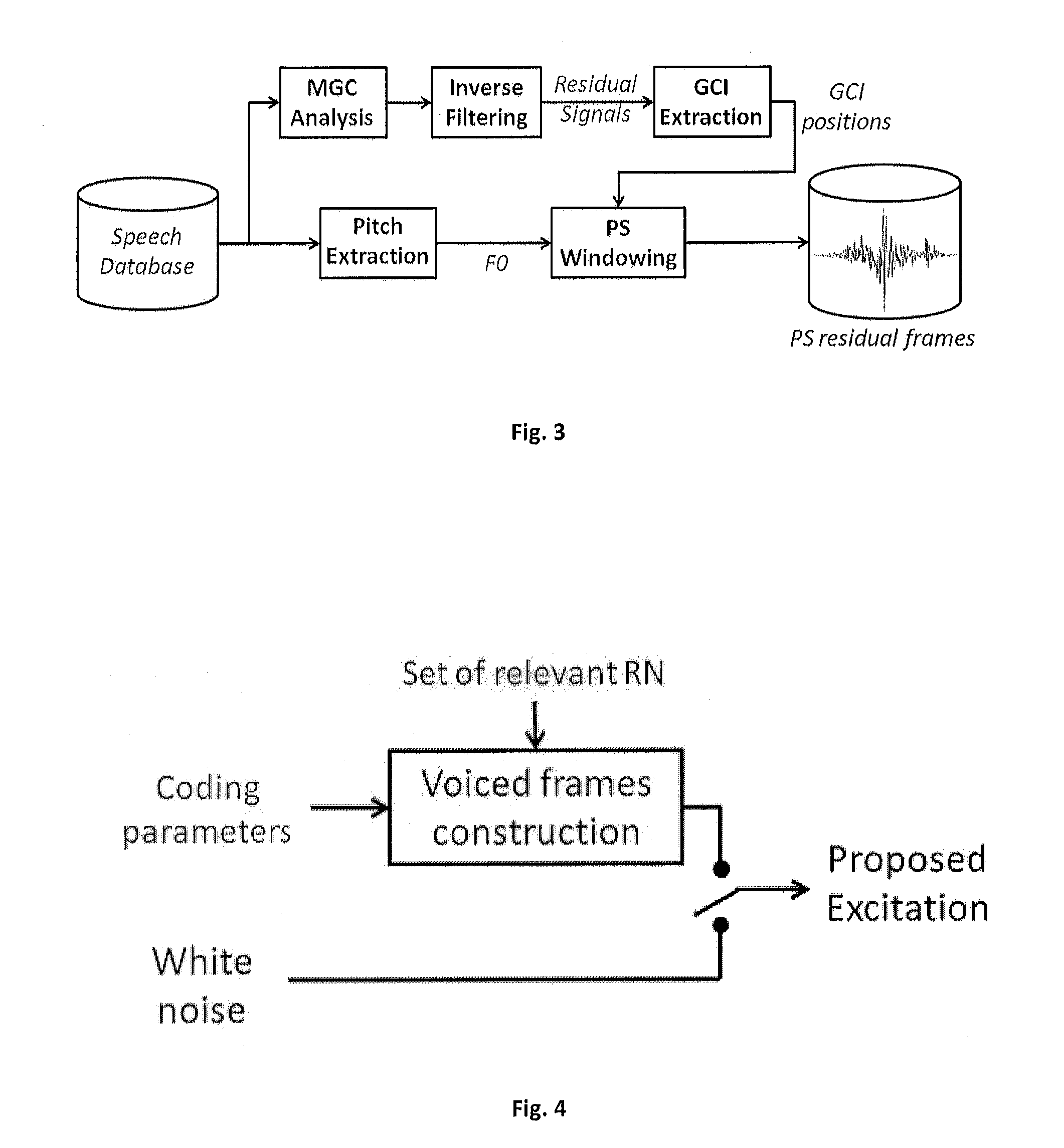Speech synthesis and coding methods
a speech synthesis and coding technology, applied in the field of speech coding and synthesis methods, can solve the problems of high frequency noise, poor delivery quality, and severe quality degradation, and achieve the effect of high frequency nois
- Summary
- Abstract
- Description
- Claims
- Application Information
AI Technical Summary
Benefits of technology
Problems solved by technology
Method used
Image
Examples
example 1
[0094]The above mentioned K-means method has first been applied on a training dataset (speech sample). Firstly, MGC analysis was performed with α=0.42 (Fs=16 kHz) and γ=−⅓, as these values gave preferred perceptual results. Said MGC analysis determined the synthesis filters.
[0095]The test sentences (not contained in the dataset) were then MGC analysed (parameters extraction, for both excitation and filters). GCIs were detected such that the framing is GCI-centred and two-period long during voiced regions. To make the selection, these frames were resampled and normalised so as to get the RN frames. These latter frames were input into the excitation signal reconstruction workflow shown in FIG. 11.
[0096]Once selected from the set of relevant normalised residual frames, each centroid normalised residual frame was modified in pitch and energy so as to replace the original one.
[0097]Unvoiced segments were replaced by a white noise segment of same energy. The resulting excitation signal wa...
example 2
[0098]In a second example, a statistical parametric speech synthesiser has been determined. The feature vectors consisted of the 24th-order MGC parameters, log-F0, and the PCA coefficients whose order has been determined as explained hereabove, concatenated together with their first and second derivatives. MCG analysis was performed with α=0.42 (Fs=16 kHz) and γ=−⅓. A Multi-Space Distribution (MSD) was used to handle voiced / unvoiced boundaries (log-F0 and PCA being determined only on voiced frames), which leads to a total of 7 streams. 5-state left-to-right context-dependent phoneme HMMs were used, using diagonal-covariance single-Gaussian distributions. A state duration model was also determined from HMM state occupancy statistics. During the speech synthesis process, the most likely state sequence is first determined according to the duration model. The most likely feature vector sequence associated to that state sequence is then generated. Finally, these feature vectors are fed i...
example 3
[0100]In a third example, the same method as in the second example was used, except that only the first eigenresidual was used, and that a high frequency noise was added, as described in the DSM model hereabove. Fmax was fixed at 4 kHz, and rs(t) was a white Gaussian noise n(t) convolved with an auto-regressive model h(τ,t) (high pass filter) and whose time structure was controlled by a parametric envelope e(t):
rs(t)=e(t)·(h(τ,t)*n(t))
Wherein e(t) is a pitch-dependent triangular function. Some further work has shown that e(t) was not a key feature of the noise structure, and can be a flat function such as e(t)=1 without degrading the final result in a perceptible way.
[0101]For each example, three voices were evaluated: Bruno (French male, not from the CMU ARCTIC database), AWB (Scottish male) and SLT (US female) from the CMU ARCTIC database. The training set had duration of about 50 min. for AWB and SLT, and 2 h for Bruno and was composed of phonetically balanced utterances sampled ...
PUM
 Login to View More
Login to View More Abstract
Description
Claims
Application Information
 Login to View More
Login to View More - R&D
- Intellectual Property
- Life Sciences
- Materials
- Tech Scout
- Unparalleled Data Quality
- Higher Quality Content
- 60% Fewer Hallucinations
Browse by: Latest US Patents, China's latest patents, Technical Efficacy Thesaurus, Application Domain, Technology Topic, Popular Technical Reports.
© 2025 PatSnap. All rights reserved.Legal|Privacy policy|Modern Slavery Act Transparency Statement|Sitemap|About US| Contact US: help@patsnap.com



